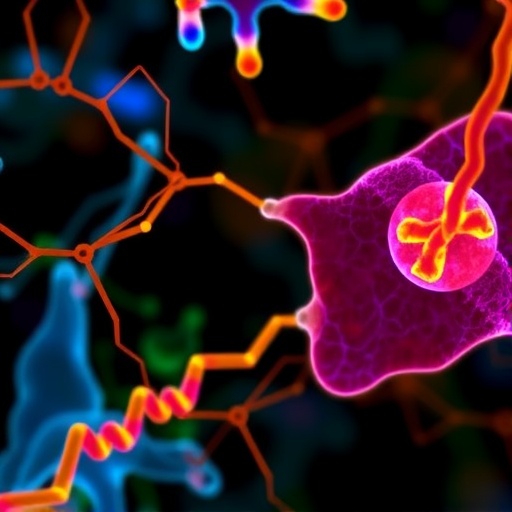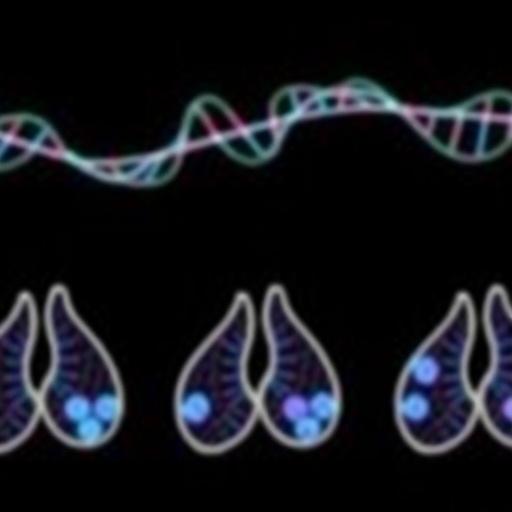
In a groundbreaking study poised to reshape our understanding of leukemia cutis (LC), researchers have unveiled a promising therapeutic avenue targeting the molecular interplay that facilitates the infiltration of acute myeloid leukemia (AML) cells into the skin. At the heart of this discovery is azelaic acid (AZA), a naturally derived compound whose antioxidant properties are harnessed to disrupt a key chemokine signaling axis involving CCL2 and its receptor CCR2. This study not only elucidates the underlying mechanisms orchestrating leukemic cell trafficking in the skin but also unveils a novel intervention strategy that could profoundly impact the treatment landscape of cutaneous leukemia manifestations.
Leukemia cutis represents a rare but critical clinical scenario where leukemic blasts invade the skin, leading to complex diagnostic and therapeutic challenges. Until now, the molecular drivers facilitating this ectopic migration of AML cells have been poorly characterized, leaving clinicians with limited targeted treatment options. Central to this new research is the chemokine CCL2 and its receptor CCR2, molecules previously implicated in inflammatory and cancer contexts but insufficiently investigated within the specific framework of AML skin infiltration.
The study pioneers by first demonstrating that oxidative stress within keratinocytes—the predominant cell type in the skin’s epidermis—can upregulate CCL2 expression. This chemokine acts as a beacon, signaling CCR2-expressing AML cells to migrate towards and infiltrate the skin. Through meticulous in vitro experiments, the researchers quantified the migration rates of leukemia cells and established a direct correlation between elevated CCL2 levels and increased leukemic cell trafficking.
.adsslot_TNcJmrsMgv{width:728px !important;height:90px !important;}
@media(max-width:1199px){ .adsslot_TNcJmrsMgv{width:468px !important;height:60px !important;}
}
@media(max-width:767px){ .adsslot_TNcJmrsMgv{width:320px !important;height:50px !important;}
}
ADVERTISEMENT
Intriguingly, the study shifts focus to azelaic acid, a dicarboxylic acid well known in dermatological contexts for its antimicrobial and anti-inflammatory effects. Prior studies hinted at its role as an antioxidant; however, its capacity to modulate leukemic cell behavior was unexplored territory. By treating keratinocytes with AZA, the research team observed a significant downregulation of CCL2 secretion, suggesting that AZA disrupts the chemotactic gradient essential for leukemic cell skin homing.
Delving deeper into the molecular pathways involved, the researchers identified that AZA’s suppressive effects on CCL2 production stem from its negative regulation of the NF-κB and MAPK signaling pathways. Both NF-κB and MAPK are pivotal inflammatory cascades known to be activated under oxidative stress and critical in regulating gene expression profiles in numerous cell types, including keratinocytes. The inhibition of these pathways arrests the transcription of key inflammatory and chemotactic genes, effectively dampening the skin’s allure for circulating leukemic cells.
Equally noteworthy is AZA’s impact on the AML cells themselves. Apart from modulating the skin microenvironment, AZA decreased the expression of CCR2 on leukemic cells, diminishing their responsiveness to CCL2’s chemotactic signals. This dual action—altering the secretion of migration cues by keratinocytes and blunting the leukemic cells’ migratory machinery—represents a comprehensive blockade of the CCL2/CCR2 axis.
Translating these findings into a biological context, the study utilized a patient-derived xenograft (PDX) AML mouse model to emulate human disease more faithfully. Intravenous administration of AZA in this model resulted in markedly lower leukemic cell presence within skin tissues compared to untreated controls. This robust in vivo evidence consolidates AZA’s potential as a therapeutic agent capable of restraining AML skin infiltration.
The implications of this research are vast. Understanding that leukemic infiltration of the skin relies heavily on the CCL2/CCR2 axis, modifiable through a well-tolerated compound like AZA, opens promising clinical avenues. AZA’s established safety profile in dermatology enhances the translational feasibility of these findings, potentially expediting clinical trials aiming to repurpose this molecule for leukemia patients suffering from skin involvement.
Additionally, the mechanistic insights into the NF-κB/MAPK pathway modulation provide a broader perspective on inflammatory signaling in the skin microenvironment during leukemia progression. Targeting these canonical pathways could also lead to synergistic interventions combining AZA with other agents aiming to restore healthy skin homeostasis and prevent leukemic cell colonization.
This study also highlights the intricate crosstalk between malignant hematopoietic cells and non-hematopoietic stromal components of the skin, illustrating how the microenvironment orchestrates disease dissemination. It underscores the importance of addressing not only the malignant cells but also the tissue niches that facilitate their survival and migration.
From a therapeutic design standpoint, the researchers employed rigorous in vitro migration assays, molecular signaling analyses, and quantitative histological assessments within their PDX model. This multi-faceted approach lends robustness and credibility to their conclusions, emphasizing the translational value of integrated experimental frameworks in cancer research.
Moreover, by focusing on keratinocytes, which are easily accessible and well-characterized skin cells, this study opens the door for topical or systemic AZA regimens tailored to modify the skin microenvironment in leukemia patients. Such strategies could complement existing systemic chemotherapy, addressing extramedullary disease reservoirs that often evade conventional treatments.
The suppression of NF-κB/MAPK signaling pathways by AZA aligns with broader research ongoing in inflammatory and oncologic dermatology, where modulating these pathways is being explored to tackle various malignancies and inflammatory disorders. Thus, this research adds an important piece to the puzzle, situating AZA as a candidate that bridges dermatology and oncology therapeutics.
Furthermore, this discovery provides a framework for screening other compounds with similar molecular targets or antioxidant properties for their potential to modulate leukemic cell trafficking. It calls for expanded research into the molecular dialogue between tumor cells and their surrounding stroma, particularly in niche tissues prone to metastasis or infiltration.
The potential clinical impact is moreover profound considering that cutaneous involvement in AML often correlates with adverse prognostic features and therapeutic resistance. An effective strategy to prevent or reverse skin infiltration could improve patient quality of life and prognosis significantly, making this line of research highly relevant to clinicians and patients alike.
Looking ahead, the exploratory nature of this work raises exciting questions on whether combination therapies incorporating AZA with other targeted agents can produce synergistic effects, further curbing leukemic dissemination and improving therapeutic outcomes. Investigating dosing regimens, long-term safety, and efficacy in human clinical trials will be critical next steps.
In summary, this pioneering study elucidates the pivotal role of the CCL2/CCR2 signaling axis in LC and establishes azelaic acid as a potent modulator capable of hindering leukemic cell trafficking into skin by disrupting NF-κB/MAPK-mediated inflammatory signaling in keratinocytes. This innovative approach holds promise to transform the management of AML patients with cutaneous manifestations and invigorates the search for microenvironmental therapies in hematologic malignancies.
Subject of Research: The role of the CCL2/CCR2 chemokine axis in leukemic cell infiltration into the skin and the therapeutic potential of azelaic acid in modulating this process through NF-κB/MAPK signaling pathways in keratinocytes.
Article Title: Azelaic acid attenuates CCL2/CCR2 axis-mediated skin trafficking of acute myeloid leukemia cells through NF-κB/MAPK signaling modulation in keratinocytes.
Article References:
Jiang, S., Ma, L., Huang, T. et al. Azelaic acid attenuates CCL2/CCR2 axis-mediated skin trafficking of acute myeloid leukemia cells through NF-κB/MAPK signaling modulation in keratinocytes. BMC Cancer 25, 1250 (2025). https://doi.org/10.1186/s12885-025-14648-1
Image Credits: Scienmag.com
DOI: https://doi.org/10.1186/s12885-025-14648-1
Tags: acute myeloid leukemia researchantioxidant properties of azelaic acidazelaic acid therapyCCL2 CCR2 interactionchemokine signaling in cancerleukemia cutis treatmentleukemic cell trafficking mechanismsnovel leukemia interventionsoxidative stress in keratinocytesskin infiltration by leukemia cellstargeted therapy for cutaneous leukemiatherapeutic strategies for leukemia





